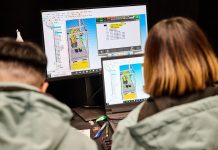Septentrio, a leader in high-precision GNSS* positioning solutions, is closely working with several major drone solutions providers including 3DR, Holybro, ARK Electronics and Systork, which is resulting in various new products that allow easier prototyping or integration of the mosaic™ GNSS receiver into UAVs.
mosaic™ is a compact triple-frequency receiver leveraging signals from all available GNSS constellations to achieve the highest degree of positioning availability, even under challenging conditions. Built-in anti-jamming and anti-spoofing** technology protects mosaic™ against intentional or unintentional interference. Such a high level of positioning robustness is important for applications where safety is a concern, for example for drone-shows and delivery drones. A high level of positioning reliability is also required by UAVs which operate in challenging environments such as around high structures, under foliage or in places of possible RF interference. In addition to collaborations with hardware integrators Septentrio also works closely with the open-source autopilot community including PX4 and Ardupilot to facilitate a smooth integration process for end-users.
“We are pleased to see the success of our current partnerships and are open to working with other integrators who are interested in making UAV-specific products with a competitive edge of superior reliability and resilience. We are also grateful for the excellent support of the community with their recent updates to PX4 and Ardupilot, which include mosaic™ features which are essential for UAVs,” commented Gustavo Lopez, Market Portfolio Manager at Septentrio.
The recently available products that bring reliable high-accuracy positioning to UAVs include Holybro H-RTK mosaic-H (dual antenna heading), 3DR mosaic-X5 CAN GPS, Systork Linnet mosaic-X5 and ARK mosaic-x5 GPS. Such products offer UAV-centered features such as magnetometer, barometer or UAVCAN communication. They also feature the mosaic™ module which receives signals from all GNSS constellations including GPS, GLONASS, Galileo, BeiDou and QZSS and outputs centimeter-level RTK positioning as well as full GNSS carrier raw data. Dual antenna operation is also supported with mosaic-H for heading and pitch or heading and roll orientation with sub-degree accuracy. Advanced anti-interference technology AIM+ not only protects the system from malicious jamming and spoofing attacks, but also reduces the risk of self-interference which occurs when nearby electronics like cameras and servos accidentally emit radio signals that interfere with GPS/GNSS.
For more information about mosaic™ or other positioning solutions please contact the Septentrio team.
* Global Navigation Satellite System including the American GPS, European Galileo, Russian GLONASS, Chinese BeiDou, Japan’s QZSS and India’s NavIC. These satellite constellations broadcast positioning information to receivers which use it to calculate their absolute position.
** Jamming is a form of radio interference which occurs when GPS frequency is overpowered by other radio waves, resulting in accuracy degradation or event total loss of position. Spoofing is a malicious form of radio interference, where misleading signals are sent into the receiver, resulting in faulty coordinates, which lead the target away from its predefined track.
About Septentrio:
Septentrio is an ISO 9001 certified manufacturer of multi-frequency multi-constellation GPS/GNSS positioning technology for demanding applications. Reliable centimeter-level positioning enables machine automation improving efficiency and safety. Septentrio provides positioning solutions for industrial applications such as robotics, construction, survey and mapping, maritime, logistics and unmanned aerial vehicles (UAVs).
Septentrio has its headquarters in Leuven, Belgium and has a world-wide presence with offices in Los Angeles, Shanghai, Seoul and Yokohama as well as numerous partners around the world. To learn more about Septentrio and its products, visit septentrio.com or follow us on LinkedIn, Twitter and GitHub.





